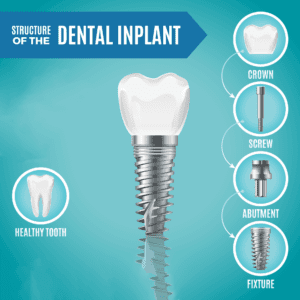Tooth loss affects millions of dental patients, leaving them with gaps in their smiles, deteriorated oral function, and at a high risk of further dental problems. To restore your dental structure and prevent more complications, you should talk to your dentist about tooth replacement solutions that will suit your unique smile.
A dentist will develop a personalized restorative dental treatment plan according to your medical history, desired results, and existing dental structure. One of the most comprehensive treatments to replace missing teeth is implant dentistry.
These fixed oral appliances can help patients who lost one, several, or an entire arch of teeth. You can feel more confident about this procedure when you know more about this specific device. Read on to learn more about the three parts of a dental implant fixture.
What Makes Up a Dental Implant?
Anchor
If you and your dentist decide to pursue implant dentistry to restore your smile after tooth loss, the first step of the process is to surgically insert a titanium post anchor into the patient’s jaw. Depending on the type of implant, or how many teeth need replacing, you can receive one, two, four, or more anchors within one oral surgery.
The anchor fuses with the bone in the jaw as you heal from this procedure. Then it establishes a solid foundation for your prosthetic teeth.
The anchor also serves as a replacement for the missing root of a tooth below the gumline. Many removable treatments, like dentures, only replace teeth above the gums and therefore cannot offer as many benefits. Implants will prevent bone loss in the jaw that might occur if you lose a tooth.
Because of the fixed nature of this anchor and the implant, dentists consider implants to be permanent dental solutions. You cannot remove the anchor or the implant without help from your dentist. But the implant can last for a lifetime.
If the anchor feels loose in your jaw or you notice extreme pain during your recovery from this initial placement procedure, call your dentist right away. These symptoms are abnormal and could point to a rare occurrence known as dental implant failure.
Abutment
The abutment is a small fixture that sits atop the anchor directly above the gumline. This serves as a secure connection between the anchor and the prosthetic teeth.
You can feel confident in the fit of your appliance thanks to the abutment. You can perform oral functions as you normally would without worrying about your device slipping out of place.
Dental Prosthetic
When you heal completely and the fusion of the anchor to the jaw is complete, you will return to your dentist’s office to receive your prosthetic teeth. The recovery period can last for three to six months.
Then your dentist will attach custom dental prosthetics to fully replace all missing teeth. You can receive a crown, bridge, or denture prosthetic depending on which teeth require replacement.
You can count on a gorgeous and natural-looking finish with this personalized approach. The material will resist staining for a long-lasting, beautiful aesthetic.

